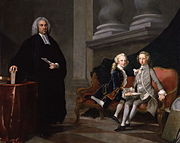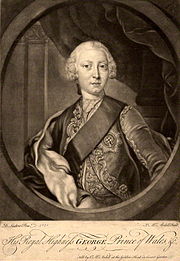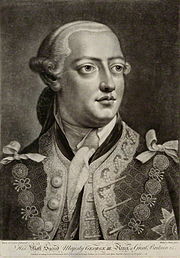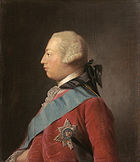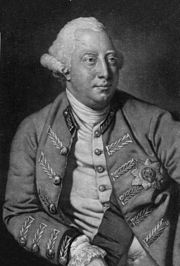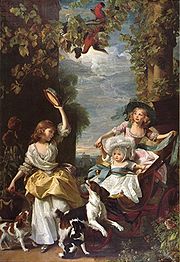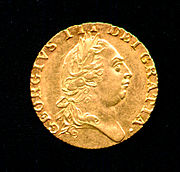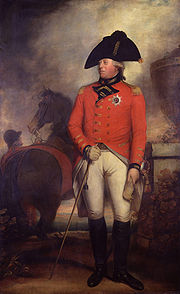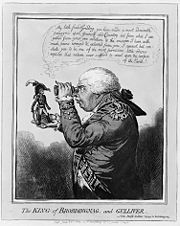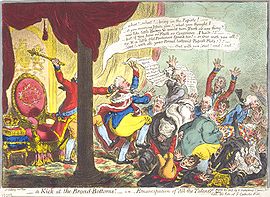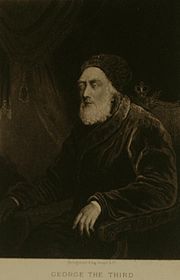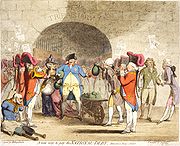
George III of the United Kingdom
Background Information
This Wikipedia selection is available offline from SOS Children for distribution in the developing world. Before you decide about sponsoring a child, why not learn about different sponsorship charities first?
| George III | |
|---|---|
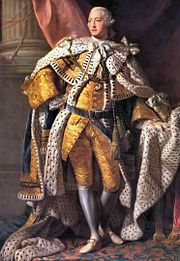 |
|
| Portrait by Allan Ramsay, 1762 | |
|
King of the United Kingdom and of Hanover ( more...) |
|
| Reign | 25 October 1760 – 29 January 1820 |
| Coronation | 22 September 1761 |
| Predecessor | George II |
| Successor | George IV |
| Regent | George, Prince Regent (1811–1820) |
| Prime Ministers |
|
| Consort | Charlotte of Mecklenburg-Strelitz |
| Issue | |
| George IV Prince Frederick, Duke of York William IV Charlotte, Princess Royal, Queen of Württemberg Prince Edward, Duke of Kent Princess Augusta Sophia Princess Elizabeth Ernest Augustus I of Hanover Prince Augustus Frederick, Duke of Sussex Prince Adolphus, Duke of Cambridge Princess Mary, Duchess of Gloucester Princess Sophia Prince Octavius Prince Alfred Princess Amelia |
|
| Full name | |
| George William Frederick | |
| House | House of Hanover |
| Father | Frederick, Prince of Wales |
| Mother | Augusta of Saxe-Gotha |
| Burial | 15 February 1820 St. George's Chapel, Windsor Castle |
| Signature |  |
| Religion | Anglican |
George III (George William Frederick; 4 June 1738 – 29 January 1820 [ N.S.]) was King of Great Britain and King of Ireland from 25 October 1760 until the union of these two countries on 1 January 1801, after which he was King of the United Kingdom of Great Britain and Ireland until his death. He was concurrently Duke and prince-elector of Brunswick-Lüneburg ("Hanover") in the Holy Roman Empire until his promotion to King of Hanover on 12 October 1814. He was the third British monarch of the House of Hanover, but unlike his two predecessors he was born in Britain and spoke English as his first language. Despite his long life, he never visited Hanover.
George III's long reign was marked by a series of military conflicts involving his kingdoms, much of the rest of Europe, and places farther afield in Africa, the Americas and Asia. Early in his reign, Great Britain defeated France in the Seven Years' War, becoming the dominant European power in North America and India. However, many of its American colonies were soon lost in the American War of Independence, which led to the establishment of the United States of America. A series of wars against revolutionary and Napoleonic France, over a 20-year period, finally concluded in the defeat of Napoleon in 1815.
In the later part of his life, George III suffered from recurrent, and eventually permanent, mental illness. Medical practitioners were baffled by this at the time, although it has since been suggested that he suffered from the blood disease porphyria. After a final relapse in 1810, a regency was established, and George III's eldest son, George, Prince of Wales, ruled as Prince Regent. On George III's death, the Prince Regent succeeded his father as George IV. Historical analysis of George III's life has gone through a "kaleidoscope of changing views" which have depended heavily on the prejudices of his biographers and the sources available to them.
Early life
George was born in London at Norfolk House. He was the grandson of King George II, and the son of Frederick, Prince of Wales, and Augusta of Saxe-Gotha. As Prince George was born two months premature and was thought unlikely to survive, he was baptised the same day by Thomas Secker, who was both Rector of St James's and the Bishop of Oxford. One month later, he was publicly baptised at Norfolk House, again by Secker. His godparents were the King of Sweden (for whom Lord Baltimore stood proxy), his uncle the Duke of Saxe-Gotha (for whom Lord Carnarvon stood proxy) and his great-aunt the Queen of Prussia (for whom Lady Charlotte Edwin stood proxy).
George grew into a healthy, but also reserved and shy child. The family moved to Leicester Square, where George and his younger brother Prince Edward, Duke of York and Albany, were educated together by private tutors. Family letters show that he could read and write in both English and German, as well as comment on political events of the time, by the age of eight. He was the first British monarch to study science systematically. Apart from chemistry and physics, his lessons included astronomy, mathematics, French, Latin, history, music, geography, commerce, agriculture and constitutional law, along with sporting and social accomplishments such as dancing, fencing, and riding. His religious education was wholly Anglican. At age 10 George took part in a family production of Joseph Addison's play Cato and said in the new prologue: "What, tho' a boy! It may with truth be said, A boy in England born, in England bred". The historian Romney Sedgwick has argued that these lines appear "to be the source of the only historical phrase with which he is associated". It is almost the earliest mention of George III.
George's grandfather, King George II, disliked the Prince of Wales and took little interest in his grandchildren. However, in 1751 the Prince of Wales died unexpectedly from a lung injury, and George became heir apparent to the throne. He inherited one of his father's titles and became the Duke of Edinburgh. Now more interested in his grandson, three weeks later the King created George Prince of Wales. (The title is not automatically acquired.)
In the spring of 1756, as George approached his eighteenth birthday, the King offered him a grand establishment at St James's Palace, but George refused the offer, guided by his mother and her confidante, Lord Bute, who would later serve as Prime Minister. George's mother, now the Dowager Princess of Wales, preferred to keep George at home where she could imbue him with her strict moral values.
Marriage
In 1759, George was smitten with Lady Sarah Lennox, sister of the Duke of Richmond, but Lord Bute advised against the match and George abandoned his thoughts of marriage. "I am born for the happiness or misery of a great nation," he wrote, "and consequently must often act contrary to my passions." Nevertheless, attempts by the King to marry George to Princess Sophia Caroline of Brunswick-Wolfenbüttel were resisted by him and his mother; Sophia married the Margrave of Bayreuth instead.
The following year, George succeeded to the Crown when his grandfather, George II, died suddenly on 25 October 1760, two weeks before his 77th birthday. The search for a suitable wife intensified. On 8 September 1761 in the Chapel Royal, St James's Palace, the King married Princess Charlotte of Mecklenburg-Strelitz, whom he met on their wedding day. A fortnight later, both were crowned at Westminster Abbey. George remarkably never took a mistress (in contrast with his grandfather and his sons), and the couple enjoyed a genuinely happy marriage. They had 15 children—nine sons and six daughters. In 1762, George purchased Buckingham House (on the site now occupied by Buckingham Palace) for use as a family retreat. His other residences were Kew and Windsor Castle. St. James's Palace was retained for official use. He did not travel extensively, and spent his entire life in southern England. In the 1790s, annual holidays were taken at Weymouth, Dorset, which he popularised as one of the first seaside resorts in England.
Early reign
George, in his accession speech to Parliament, proclaimed: "Born and educated in this country, I glory in the name of Britain". George inserted this phrase into the speech, written by Lord Hardwicke, and it demonstrated George's desire to distance himself from his German forebears, who were perceived as caring more for Hanover than for Britain. The historians Brendan Simms and Torsten Riotte have argued that "The majority of historians have accepted this statement as the core of George III's political beliefs and as an argument against the importance of the dynastic union under the third Hanoverian".
Although George's accession was at first welcomed by politicians of all parties, the first years of George's reign were marked by political instability, largely generated as a result of disagreements over the Seven Years' War. George was perceived as favouring Tory ministers, which led to his denunciation by the Whigs as an autocrat. On George's accession, the Crown lands produced relatively little income; most revenue was generated through taxes and excise duties. George surrendered the Crown Estate to Parliamentary control in return for a Civil List annuity for the support of his household and the expenses of Civil Government. Claims that George used the income to reward supporters with bribes and gifts are disputed by historians who say such claims "rest on nothing but falsehoods put out by disgruntled opposition". Debts amounting to over £3 million over the course of George's reign were paid by Parliament, and the Civil List annuity was increased from time to time. George aided the Royal Academy with large grants from his private funds, and may have donated more than half of his personal income to charity. Of George's art collection, the two most notable purchases are Vermeer's Lady at the Virginals and a set of Canalettos, but it is as a collector of books that he is best remembered. The King's Library was open and available to scholars and was the foundation of a new national library.
In May 1762, the incumbent Whig ministry of the Duke of Newcastle was replaced with one led by the Scottish Tory Lord Bute. Bute's opponents worked against him by spreading the calumny that he was having an affair with the King's mother, and by exploiting anti-Scottish prejudices amongst the English. John Wilkes, a Member of Parliament, published The North Briton, which was both inflammatory and defamatory in its condemnation of Bute and the government. Wilkes was eventually arrested for seditious libel but he fled to France to escape punishment; he was expelled from the House of Commons, and found guilty in absentia of blasphemy and libel. In 1763, after concluding the Peace of Paris which ended the war, Lord Bute resigned, allowing the Whigs under George Grenville to return to power.
Later that year, the Royal Proclamation of 1763 placed a boundary upon the westward expansion of the American colonies. The Proclamation aimed to force colonists to negotiate with the Native Americans, and therefore to reduce the costly frontier warfare that had erupted over land conflicts. While the Proclamation Line, as it came to be known, did not bother the majority of settled farmers, it was unpopular with a vocal minority of Americans and ultimately contributed to conflict between the colonists and the British government. With the American colonists generally unburdened by British taxes, the government found it increasingly difficult to pay for the defence of the colonies against native uprisings and the possibility of French incursions. In 1765, Grenville introduced the Stamp Act, which levied a stamp duty on every document in the British colonies in North America. Since newspapers were printed on stamped paper, those most affected by the introduction of the duty were the most effective at producing propaganda opposing the tax. Meanwhile, the King had become exasperated at Grenville's attempts to reduce the King's prerogatives, and tried, unsuccessfully, to persuade William Pitt the Elder to accept the office of Prime Minister. After a brief illness, which may have presaged his illnesses to come, George settled on Lord Rockingham to form a ministry, and dismissed Grenville.
Lord Rockingham, with the support of Pitt and the King, repealed Grenville's unpopular Stamp Act, but his government was weak and he was replaced in 1766 by Pitt, whom George created Earl of Chatham. The actions of Lord Chatham and George III in repealing the Act were so popular in America that statues of them both were erected in New York City. Lord Chatham fell ill in 1767, and the Duke of Grafton took over the government, although he did not formally become Prime Minister until 1768. That year, John Wilkes returned to England, stood as a candidate in the general election, and came top of the poll in the Middlesex constituency. Wilkes was again expelled from Parliament. Wilkes was re-elected and expelled twice more, before the House of Commons resolved that his candidature was invalid and declared the runner-up as the victor. Grafton's government disintegrated in 1770, allowing the Tories led by Lord North to return to power.
George was deeply devout and spent hours in prayer, but his piety was not shared by his brothers. George was appalled by what he saw as their loose morals. In 1770, his brother Prince Henry, Duke of Cumberland and Strathearn, was exposed as an adulterer, and the following year Cumberland married a young widow, Anne Horton. The King considered her inappropriate as a royal bride: she was from a lower social class and German law barred any children of the couple from the Hanoverian succession. George insisted on a new law that essentially forbade members of the Royal Family from legally marrying without the consent of the Sovereign. The subsequent bill was unpopular in Parliament, including among George's own ministers, but passed as the Royal Marriages Act 1772. Shortly afterward, another of George's brothers, Prince William Henry, Duke of Gloucester and Edinburgh, revealed he had been secretly married to Maria, Countess Waldegrave, the illegitimate daughter of Sir Edward Walpole. The news confirmed George's opinion that he had been right to introduce the law: Maria was related to his political opponents. Neither lady was ever received at court.
Lord North's government was chiefly concerned with discontent in America. To assuage American opinion most of the custom duties were withdrawn, except for the tea duty, which in George's words was "one tax to keep up the right [to levy taxes]". In 1773, the tea ships moored in Boston Harbour were boarded by colonists and the tea thrown overboard, an event that became known as the Boston Tea Party. In Britain, opinion hardened against the colonists, with Chatham now agreeing with North that the destruction of the tea was "certainly criminal". With the clear support of Parliament Lord North introduced measures, which were called the Intolerable Acts by the colonists: the Port of Boston was shut down and the charter of Massachusetts was altered so that the upper house of the legislature was appointed by the Crown instead of elected by the lower house. Up to this point, in the words of Professor Peter Thomas, George's "hopes were centred on a political solution, and he always bowed to his cabinet's opinions even when sceptical of their success. The detailed evidence of the years from 1763 to 1775 tends to exonerate George III from any real responsibility for the American Revolution." Though the Americans characterised George as a tyrant, in these years he acted as a constitutional monarch supporting the initiatives of his ministers.
| British Royalty |
| House of Hanover |
|---|
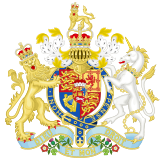 |
| George III |
|
American War of Independence
The American War of Independence began when armed conflict between British regulars and colonial militiamen broke out in New England in April 1775. After a year of fighting, the colonies declared their independence from the Crown as "free and independent States" in July 1776, and listed grievances against the British king, legislature, and populace. Among George's other offences, the Declaration charged, "He has abdicated Government here ... He has plundered our seas, ravaged our Coasts, burnt our towns, and destroyed the lives of our people." The gilded equestrian statue of George III in New York was pulled down. The British lost Boston in 1776 but captured New York later that year. The war became a personal issue for the King, fuelled by his growing belief that British leniency would be taken as weakness by the Americans. The King thought he was defending Britain's constitution against usurpers, rather than opposing patriots fighting for their natural rights. The grand strategic plan of invading from Canada and cutting off New England failed with the surrender of the British Lieutenant-General John Burgoyne at the Battle of Saratoga.
George III is often accused of obstinately trying to keep Great Britain at war with the revolutionaries in America, despite the opinions of his own ministers. In the words of the Victorian author George Trevelyan, the King was determined "never to acknowledge the independence of the Americans, and to punish their contumacy by the indefinite prolongation of a war which promised to be eternal." The King wanted to "keep the rebels harassed, anxious, and poor, until the day when, by a natural and inevitable process, discontent and disappointment were converted into penitence and remorse". However, more recent historians defend George by saying in the context of the times no king would willingly surrender such a large territory, and his conduct was far less ruthless than contemporary monarchs in Europe. After Saratoga, both Parliament and the British people were in favour of the war; recruitment ran at high levels and although political opponents were vocal, they remained a small minority. With the setbacks in America, Prime Minister Lord North asked to transfer power to Lord Chatham, whom he thought more capable, but George refused to do so; he suggested instead that Chatham serve as a subordinate minister in Lord North's administration, but Chatham refused to cooperate. He died later in the same year. In 1778, France (Britain's chief rival) signed a treaty of friendship with the American States. Great Britain was then at war with France, and in 1779 it was also at war with Spain. Lord Gower and Lord Weymouth both resigned from the government. Lord North again requested that he also be allowed to resign, but he stayed in office at George III's insistence. Opposition to the costly war was increasing, and in June 1780 contributed to disturbances in London known as the Gordon riots.
In 1781, the news of Lord Cornwallis's surrender at the Siege of Yorktown reached London; Lord North's parliamentary support ebbed away and he resigned the following year. The King drafted an abdication notice, which was never delivered, finally accepted the defeat in North America, and authorised the negotiation of a peace. The Treaties of Paris, by which Britain recognised the independence of the American states and returned Florida to Spain, were ratified in 1783. When John Adams was appointed American Minister to Britain in 1785, George had become resigned to the new relationship between his country and the States. He told Adams, "I was the last to consent to the separation; but the separation having been made and having become inevitable, I have always said, as I say now, that I would be the first to meet the friendship of the United States as an independent power."
Constitutional struggle
With the collapse of Lord North's ministry in 1782, the Whig Lord Rockingham became Prime Minister for the second time, but died within months. The King then appointed Lord Shelburne to replace him. Charles James Fox, however, refused to serve under Shelburne, and demanded the appointment of the Duke of Portland. In 1783, the House of Commons forced Lord Shelburne from office and his government was replaced by the Fox-North Coalition. The Duke of Portland became Prime Minister, with Fox and Lord North, as Foreign Secretary and Home Secretary respectively.
The King disliked Fox intensely, both for his politics as well as his character; he thought Fox was unprincipled and a bad influence on the Prince of Wales. George III was distressed at having to appoint ministers not of his liking, but the Portland ministry quickly built up a majority in the House of Commons, and could not be displaced easily. He was further dismayed when the government introduced the India Bill, which proposed to reform the government of India by transferring political power from the Honourable East India Company to Parliamentary commissioners. Although the King actually favoured greater control over the Company, the proposed commissioners were all political allies of Fox. Immediately after the House of Commons passed it, George authorised Lord Temple to inform the House of Lords that he would regard any peer who voted for the bill as his enemy. The bill was rejected by the Lords; three days later, the Portland ministry was dismissed, and William Pitt the Younger was appointed Prime Minister, with Temple as his Secretary of State. On 17 December 1783, Parliament voted in favour of a motion condemning the influence of the monarch in parliamentary voting as a "high crime" and Temple was forced to resign. Temple's departure destabilised the government, and three months later the government lost its majority and Parliament was dissolved; the subsequent election gave Pitt a firm mandate.
William Pitt
For George III, Pitt's appointment was a great victory. It proved that he was able to appoint Prime Ministers on the basis of his own interpretation of the public mood without having to follow the choice of the current majority in the House of Commons. Throughout Pitt's ministry, George supported many of Pitt's political aims and created new peers at an unprecedented rate to increase the number of Pitt's supporters in the House of Lords. During and after Pitt's ministry, George III was extremely popular in Britain. The British people admired him for his piety, and for remaining faithful to his wife. He was fond of his children, and was devastated at the death of two of his sons in infancy in 1782 and 1783 respectively. Nevertheless, he set his children a strict regimen. They were expected to attend rigorous lessons from seven in the morning, and to lead lives of religious observance and virtue. When his children strayed from George's own principles of righteousness, as his sons did as young adults, he was dismayed and disappointed.
However, by this time George's health was deteriorating. He suffered from a mental illness, which was possibly a symptom of the genetic disease, porphyria, although this has been questioned. A study of samples of the King's hair published in 2005 revealed high levels of arsenic, a possible trigger for the disease. The source of the arsenic is not known, but it could have been a component of medicines or cosmetics. The King may have suffered a brief episode of disease in 1765, but a longer episode began in the summer of 1788. At the end of the parliamentary session, he went to Cheltenham Spa to recuperate. It was the furthest he had ever been from London—just short of 100 miles (150 km)—but his condition worsened. In November he became seriously deranged, sometimes speaking for many hours without pause, causing him to foam at the mouth and making his voice hoarse. With his doctors largely at a loss to explain his illness, spurious stories about his condition spread, such as the claim that he shook hands with a tree in the mistaken belief that it was the King of Prussia. Treatment for mental illness was primitive by modern standards, and the King's doctors, who included Francis Willis, treated the King by forcibly restraining him until he was calm, or applying caustic poultices to draw out "evil humours".
In the reconvened Parliament, Fox and Pitt wrangled over the terms of the regency. While both agreed that it would be most reasonable for George III's eldest son and heir apparent, the Prince of Wales, to act as Regent, to Pitt’s consternation Fox suggested that it was the Prince of Wales's absolute right to act on his ill father's behalf with full powers. Pitt, fearing he would be removed from office if the Prince of Wales were empowered, argued that it was for Parliament to nominate a Regent, and wanted to restrict the Regent's authority. In February 1789, the Regency Bill, authorising the Prince of Wales to act as Prince Regent, was introduced and passed in the House of Commons, but before the House of Lords could pass the bill, George III recovered.
French Revolutionary and Napoleonic Wars
After George’s recovery, his popularity, and that of Pitt, continued to increase at the expense of Fox and the Prince of Wales. His humane and understanding treatment of two insane assailants, Margaret Nicholson in 1786 and John Frith in 1790, contributed to his popularity. A failed attempt to assassinate the King on 15 May 1800 was not political in origin but motivated by the delusions of James Hadfield, who shot at the King in the Drury Lane Theatre. George seemed unperturbed by the incident, so much so that he fell asleep in the interval.
The French Revolution of 1789, in which the French monarchy had been overthrown, worried many British landowners. France declared war on Great Britain in 1793; in the war attempt, George allowed Pitt to increase taxes, raise armies, and suspend the right of habeas corpus. The First Coalition to oppose revolutionary France, which included Austria, Prussia, and Spain, broke up in 1795 when Prussia and Spain made separate peace with France. The Second Coalition, which included Austria, Russia, and the Ottoman Empire, was defeated in 1800. Only Great Britain was left fighting Napoleon Bonaparte, the First Consul of the French Republic.
A brief lull in hostilities allowed Pitt to concentrate effort on Ireland, where there had been an uprising and attempted French landing in 1798. The British and Irish Parliaments passed the Act of Union 1800, which, on 1 January 1801, united Great Britain and Ireland into a single nation, known as the United Kingdom of Great Britain and Ireland. George used the opportunity to drop the claim to the Throne of France, which English and British Sovereigns had maintained since the reign of Edward III. It was suggested that George adopt the title " Emperor of the British Isles", but he refused. As part of his Irish policy, Pitt planned to remove certain legal disabilities that applied to Roman Catholics. George III claimed that to emancipate Catholics would be to violate his coronation oath, in which Sovereigns promise to maintain Protestantism. Faced with opposition to his religious reform policies from both the King and the British public, Pitt threatened to resign. At about the same time, the King suffered a relapse of his previous illness, which he blamed on worry over the Catholic question. On 14 March 1801, Pitt was formally replaced by the Speaker of the House of Commons, Henry Addington. Addington opposed emancipation, instituted annual accounts, abolished income tax and began a programme of disarmament. In October 1801, he made peace with the French, and in 1802 signed the Treaty of Amiens.
George did not consider the peace with France as real; in his view it was an "experiment". In 1803, the war resumed but public opinion distrusted Addington to lead the nation in war, and instead favoured Pitt. An invasion of England by Napoleon seemed imminent, and a massive volunteer movement arose to defend England against the French. George's review of 27,000 volunteers in Hyde Park, London, on 26 and 28 October 1803 and at the height of the invasion scare, attracted an estimated 500,000 spectators on each day. The Times said, "The enthusiasm of the multitude was beyond all expression." A courtier wrote on 13 November that, "The King is really prepared to take the field in case of attack, his beds are ready and he can move at half an hour's warning". George wrote to his friend Bishop Hurd, "We are here in daily expectation that Bonaparte will attempt his threatened invasion ... Should his troops effect a landing, I shall certainly put myself at the head of mine, and my other armed subjects, to repel them." After Admiral Lord Nelson's famous naval victory at the Battle of Trafalgar, the possibility of invasion was extinguished.
In 1804, George was again affected by his recurrent illness; after his recovery, Addington resigned and Pitt regained power. Pitt sought to appoint Fox to his ministry, but George III refused. Lord Grenville perceived an injustice to Fox, and refused to join the new ministry. Pitt concentrated on forming a coalition with Austria, Russia, and Sweden. This Third Coalition, however, met the same fate as the First and Second Coalitions, collapsing in 1805. The setbacks in Europe took a toll on Pitt's health and he died in 1806, reopening the question of who should serve in the ministry. Lord Grenville became Prime Minister, and his " Ministry of All the Talents" included Fox. The King was conciliatory towards Fox, after being forced to capitulate over his appointment. After Fox's death in September 1806, the King and ministry were in open conflict. To boost recruitment, the ministry proposed a measure in February 1807 whereby Roman Catholics would be allowed to serve in all ranks of the Armed Forces. George instructed them not only to drop the measure, but also to agree never to set up such a measure again. The ministers agreed to drop the measure then pending, but refused to bind themselves in the future. They were dismissed and replaced by the Duke of Portland as the nominal Prime Minister, with actual power being held by the Chancellor of the Exchequer, Spencer Perceval. Parliament was dissolved, and the subsequent election gave the ministry a strong majority in the House of Commons. George III made no further major political decisions during his reign; the replacement of the Duke of Portland by Perceval in 1809 was of little actual significance.
Later life
In late 1810, at the height of his popularity but already virtually blind with cataracts and in pain from rheumatism, George III became dangerously ill. In his view the malady had been triggered by the stress he suffered at the death of his youngest and favourite daughter, Princess Amelia. The Princess's nurse reported that "the scenes of distress and crying every day ... were melancholy beyond description." He accepted the need for the Regency Act of 1811, and the Prince of Wales acted as Regent for the remainder of George III's life. By the end of 1811, George III had become permanently insane and lived in seclusion at Windsor Castle until his death.
Perceval was assassinated in 1812 (the only British Prime Minister to have suffered such a fate) and was replaced by Lord Liverpool. Liverpool oversaw British victory in the Napoleonic Wars. The subsequent Congress of Vienna led to significant territorial gains for Hanover, which was upgraded from an electorate to a kingdom.
Meanwhile, George's health deteriorated. He suffered from dementia and became completely blind and increasingly deaf. He was incapable of knowing or understanding either that he was declared King of Hanover in 1814, or that his wife died in 1818. Over Christmas 1819, he spoke nonsense for 58 hours, and for the last few weeks of his life was unable to walk. He died at Windsor Castle at 8:38 p.m. on 29 January 1820, six days after the death of his fourth son, the Duke of Kent. His favourite son, Frederick, Duke of York, was with him. George III was buried on 16 February in St. George's Chapel, Windsor Castle.
George was succeeded by two of his sons George IV and William IV, who both died without surviving legitimate children, leaving the throne to their niece, Victoria, the last monarch of the House of Hanover and the only legitimate child of the Duke of Kent.
Legacy
George III lived for 81 years and 239 days and reigned for 59 years and 96 days: both his life and his reign were longer than those of any of his predecessors. Only George's granddaughter Queen Victoria exceeded his record, though Elizabeth II has lived longer.
George III was dubbed "Farmer George" by satirists, at first mocking his interest in mundane matters rather than politics but later to contrast his homely thrift with his son's grandiosity and to portray him as a man of the people. Under George III, who was passionately interested in agriculture, the British Agricultural Revolution reached its peak and great advances were made in fields such as science and industry. There was unprecedented growth in the rural population, which in turn provided much of the workforce for the concurrent Industrial Revolution. George's collection of mathematical and scientific instruments is now housed in the Science Museum (London); he funded the construction and maintenance of William Herschel's forty-foot telescope, which was the biggest ever built at the time. Herschel discovered the planet Uranus, which he at first named after George, in 1781.
George III himself hoped that "the tongue of malice may not paint my intentions in those colours she admires, nor the sycophant extoll me beyond what I deserve", but in the popular mind George III has been both demonised and praised. While very popular at the start of his reign, by the mid-1770s George had lost the loyalty of revolutionary American colonists, though it has been estimated that as many as half of the colonists remained loyal. The grievances in the United States Declaration of Independence were presented as "repeated injuries and usurpations" that he had committed to establish an "absolute Tyranny" over the colonies. The Declaration's wording has contributed to the American public's perception of George as a tyrant. Contemporary accounts of George III's life fall into two camps: one demonstrating "attitudes dominant in the latter part of the reign, when the King had become a revered symbol of national resistance to French ideas and French power" and the other "derived their views of the King from the bitter partisan strife of the first two decades of the reign, and they expressed in their works the views of the opposition". Building on the latter of these two assessments, British historians of the nineteenth and early twentieth centuries, such as Trevelyan and Erskine May, promoted hostile interpretations of George III's life. However, in the mid-twentieth century the work of Lewis Namier, who thought George was "much maligned", kick-started a re-evaluation of the man and his reign. Scholars of the later twentieth century, such as Butterfield and Pares, and Macalpine and Hunter, are inclined to treat George sympathetically, seeing him as a victim of circumstance and illness. Butterfield rejected the arguments of his Victorian predecessors with withering disdain: "Erskine May must be a good example of the way in which an historian may fall into error through an excess of brilliance. His capacity for synthesis, and his ability to dovetail the various parts of the evidence ... carried him into a more profound and complicated elaboration of error than some of his more pedestrian predecessors ... he inserted a doctrinal element into his history which, granted his original aberrations, was calculated to project the lines of his error, carrying his work still further from centrality or truth." In pursuing war with the American colonists, George III believed he was defending the right of an elected Parliament to levy taxes, not seeking to expand his own power or prerogatives. In the opinion of modern scholars, during the long reign of George III the monarchy continued to lose its political power, and grew as the embodiment of national morality.
Titles, styles, honours and arms
Titles and styles
- 4 June 1738 – 31 March 1751: His Royal Highness Prince George
- 31 March 1751 – 20 April 1751: His Royal Highness The Duke of Edinburgh
- 20 April 1751 – 25 October 1760: His Royal Highness The Prince of Wales
- 25 October 1760 – 29 January 1820: His Majesty The King
In Great Britain, George III used the official style "George the Third, by the Grace of God, King of Great Britain, France, and Ireland, Defender of the Faith, and so forth" In 1801, when Great Britain united with Ireland, he dropped his claim to the French Throne. His style became, "George the Third, by the Grace of God, of the United Kingdom of Great Britain and Ireland King, Defender of the Faith."
In Germany, he was Duke of Brunswick and Lüneburg, Archtreasurer and Prince-Elector of the Holy Roman Empire until the end of the empire in 1806. He then continued as Duke until the Congress of Vienna declared him King of Hanover in 1814.
Arms
Before his succession, George was granted the royal arms differenced by a label azure of five points, the centre point bearing a fleur-de-lys or on 27 July 1749. Upon his father's death, and along with the dukedom of Edinburgh and the position of heir-apparent, he inherited his difference of a plain label argent of three points. In an additional difference, the crown of Charlemagne was not usually depicted on the arms of the heir, only on the Sovereign's.
From his succession until 1800, George used the royal arms: Quarterly, I Gules three lions passant guardant in pale Or (for England) impaling Or a lion rampant within a double-tressure flory-counter-flory Gules (for Scotland); II Azure three fleurs-de-lys Or (for France); III Azure a harp Or stringed Argent (for Ireland); IV tierced per pale and per chevron (for Hanover), I Gules two lions passant guardant Or (for Brunswick), II Or a semy of hearts Gules a lion rampant Azure (for Lüneburg), III Gules a horse courant Argent (for Westfalen), overall an escutcheon Gules charged with the crown of Charlemagne Or (for the dignity of Archtreasurer of the Holy Roman Empire).
Following the Act of Union 1800, the royal arms were amended, dropping the French quartering. They became: Quarterly, I and IV England; II Scotland; III Ireland; overall an escutcheon of Hanover surmounted by an electoral bonnet. In 1816, after the Electorate of Hanover became a kingdom, the electoral bonnet was changed to a crown.
Issue
| Name | Birth | Death | Notes |
|---|---|---|---|
| George IV | 12 August 1762 | 26 June 1830 | (1) married 1785, in contravention of the Royal Marriages Act 1772, Maria Fitzherbert; no issue; (2) married 1795, Princess Caroline of Brunswick-Wolfenbüttel; had issue; died aged 67 |
| Frederick, Duke of York | 16 August 1763 | 5 January 1827 | married 1791, Princess Frederica of Prussia; no issue; died aged 63 |
| William IV | 21 August 1765 | 20 June 1837 | married 1818, Adelaide of Saxe-Meiningen; no legitimate surviving issue; died aged 71 |
| Charlotte, Princess Royal | 29 September 1766 | 6 October 1828 | married 1797, Frederick, King of Württemberg; no issue; died aged 62 |
| Edward, Duke of Kent | 2 November 1767 | 23 January 1820 | married 1818, Princess Victoria of Saxe-Coburg-Saalfeld; had issue (Queen Victoria); died aged 52 |
| Princess Augusta Sophia | 8 November 1768 | 22 September 1840 | died aged 71 |
| Princess Elizabeth | 22 May 1770 | 10 January 1840 | married 1818, Frederick, Landgrave of Hesse-Homburg; no issue; died aged 69 |
| Ernest Augustus I of Hanover, Duke of Cumberland | 5 June 1771 | 18 November 1851 | married 1815, Princess Frederica of Mecklenburg-Strelitz; had issue; died aged 80 |
| Augustus Frederick, Duke of Sussex | 27 January 1773 | 22 April 1843 | married in contravention of the Royal Marriages Act 1772, (1) 1793 Lady Augusta Murray; had issue; marriage declared void 1794; (2) 1831, Lady Cecilia Underwood (later 1st Duchess of Inverness); no issue; died aged 70 |
| Adolphus, Duke of Cambridge | 24 February 1774 | 8 July 1850 | married 1818, Princess Augusta of Hesse-Cassel; had issue; died aged 76 |
| Princess Mary, Duchess of Gloucester | 25 April 1776 | 30 April 1857 | married 1816, Prince William, Duke of Gloucester; no issue; died aged 81 |
| Princess Sophia | 3 November 1777 | 27 May 1848 | died aged 70 |
| Prince Octavius | 23 February 1779 | 3 May 1783 | died aged 4 |
| Prince Alfred | 22 September 1780 | 20 August 1782 | died aged 23 months |
| Princess Amelia | 7 August 1783 | 2 November 1810 | died aged 27 |
Ancestors
| Ancestors of George III of the United Kingdom | ||||||||||||||||||||||||||||||||||||||||||||||||||||||||||||||||||||||||||||||||||||||||||||||||||||||||||||||||||||||||||||||||||||||||||||||||||||||||||||||||||||||||||||||||||||||||||||||||||||||||||||||||||||||||||||||||||||||||||||||||||||||||||||||||||||||||||||||||||||||||||||||||||||||||||||||||||||||||||||||||||||||||||||||||||||||||||||||||||||||||||||||||||||||||||||||||||||||||||||||||||||||||||||||||||||||||||||||||||||||||||||||||||||||||||||||||||||||||||||||||||||||||||||||||||||||||||||||||||||||||||||||||||||||||||||||||||
|---|---|---|---|---|---|---|---|---|---|---|---|---|---|---|---|---|---|---|---|---|---|---|---|---|---|---|---|---|---|---|---|---|---|---|---|---|---|---|---|---|---|---|---|---|---|---|---|---|---|---|---|---|---|---|---|---|---|---|---|---|---|---|---|---|---|---|---|---|---|---|---|---|---|---|---|---|---|---|---|---|---|---|---|---|---|---|---|---|---|---|---|---|---|---|---|---|---|---|---|---|---|---|---|---|---|---|---|---|---|---|---|---|---|---|---|---|---|---|---|---|---|---|---|---|---|---|---|---|---|---|---|---|---|---|---|---|---|---|---|---|---|---|---|---|---|---|---|---|---|---|---|---|---|---|---|---|---|---|---|---|---|---|---|---|---|---|---|---|---|---|---|---|---|---|---|---|---|---|---|---|---|---|---|---|---|---|---|---|---|---|---|---|---|---|---|---|---|---|---|---|---|---|---|---|---|---|---|---|---|---|---|---|---|---|---|---|---|---|---|---|---|---|---|---|---|---|---|---|---|---|---|---|---|---|---|---|---|---|---|---|---|---|---|---|---|---|---|---|---|---|---|---|---|---|---|---|---|---|---|---|---|---|---|---|---|---|---|---|---|---|---|---|---|---|---|---|---|---|---|---|---|---|---|---|---|---|---|---|---|---|---|---|---|---|---|---|---|---|---|---|---|---|---|---|---|---|---|---|---|---|---|---|---|---|---|---|---|---|---|---|---|---|---|---|---|---|---|---|---|---|---|---|---|---|---|---|---|---|---|---|---|---|---|---|---|---|---|---|---|---|---|---|---|---|---|---|---|---|---|---|---|---|---|---|---|---|---|---|---|---|---|---|---|---|---|---|---|---|---|---|---|---|---|---|---|---|---|---|---|---|---|---|---|---|---|---|---|---|---|---|---|---|---|---|---|---|---|---|---|---|---|---|---|---|---|---|---|---|---|---|---|---|---|---|---|---|---|---|---|---|---|---|---|---|---|---|---|---|---|---|---|---|---|---|---|---|---|---|---|---|---|---|---|---|---|---|---|---|---|---|---|---|---|---|---|---|---|---|---|---|---|---|---|---|---|---|---|---|---|---|---|---|---|---|---|---|---|---|---|---|---|---|---|---|---|---|---|---|---|---|---|---|---|---|---|---|---|---|---|---|---|---|---|---|---|---|---|---|---|---|---|---|---|---|---|---|---|---|---|---|---|---|---|---|---|---|---|---|---|---|---|---|---|---|---|---|
|
||||||||||||||||||||||||||||||||||||||||||||||||||||||||||||||||||||||||||||||||||||||||||||||||||||||||||||||||||||||||||||||||||||||||||||||||||||||||||||||||||||||||||||||||||||||||||||||||||||||||||||||||||||||||||||||||||||||||||||||||||||||||||||||||||||||||||||||||||||||||||||||||||||||||||||||||||||||||||||||||||||||||||||||||||||||||||||||||||||||||||||||||||||||||||||||||||||||||||||||||||||||||||||||||||||||||||||||||||||||||||||||||||||||||||||||||||||||||||||||||||||||||||||||||||||||||||||||||||||||||||||||||||||||||||||||||||
